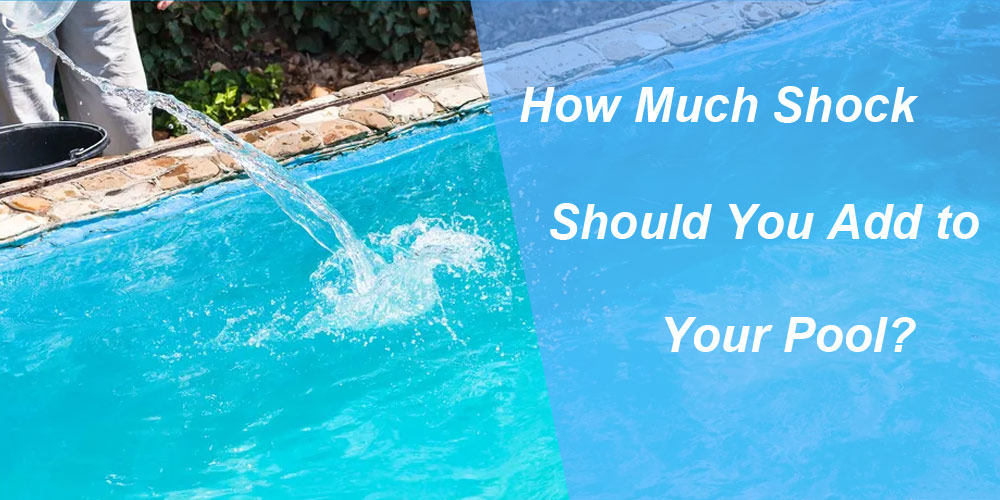Pool shock is an effective way to maintain the health of your pool. Pool shock, also known as chlorine shock, is a method of using highly efficient, fast-dissolving chlorine disinfectants to quickly oxidize pollutants in the water and remove pool algae, bacteria, and viruses. But how much chlorine shock agent do you need to add to your pool? This depends on the size of the pool, the type of shock agent, and the current state of the pool.
When is chlorine shock needed?
- After a rainstorm, rain and wind will bring impurities such as sludge and pollen into the pool.
- After a large number of swimmers use the pool, a large number of bacteria and other organic matter will be produced in the pool.
- Before opening the pool for the first time, it is necessary to quickly disinfect the pool to quickly kill bacteria in the pool.
- When a large-scale algae outbreak occurs, it is necessary to quickly kill the algae to prevent it from spreading.
Factors that affect the amount of chlorine shock agent used:
Pool size: Generally, the larger the pool capacity and the more water in the pool, the more chlorine shock agent needs to be added.
Free chlorine content: Test the pool chemistry before shocking. If the free chlorine content is high, less shock agent is needed.
Pool pollution level: The more serious the pollution, the more chlorine shock agent may be needed.
Shock type: Different shock products have different wind strengths. Common chlorine shock agents include sodium dichloroisocyanurate and calcium hypochlorite. The available chlorine content of calcium hypochlorite is usually 65% and 70%, and the available chlorine content of SDIC is 60% and 56%. The amount of products with different available chlorine content is different.
Swimming pool shock dosage calculation
Calculating the amount of shock agent to be added to the pool depends largely on the size of the pool and the type of shock treatment.
Determine the capacity of the pool
First, calculate the capacity of the pool. You can use the following formula to calculate:
To calculate the volume of a swimming pool, you’ll need to consider its shape. Here are some common shapes and their corresponding formulas:
Rectangular Pools:
Volume = Length × Width × Depth
This is the simplest calculation. Simply multiply the length, width, and average depth of your pool.
Circular Pools:
Volume = π × Radius² × Depth
Here, π is a mathematical constant approximately equal to 3.14159. The radius is half the diameter of the circle.
Oval Pools:
Volume ≈ 0.785 × Length × Width × Depth
This is an approximation. The exact formula can be more complex based on the specific shape of the oval.
Understand the recommended dosage
Different shock products have different dosages, so it is important to check the label of the shock you use.
A general rule of thumb for adding a calcium hypochlorite shock is:
Standard shock disinfection:
For general water cleaning, a dosage of about 10-20 grams per ton of water is recommended.
Severe pollution or algae outbreak:
If the pool water is seriously polluted or algae bloom occurs, the dosage can be increased to 20-30 grams/ton.
The typical dosage of Sodium Dichloroisocyanurate Granules (NaDCC) for swimming pool shock treatment depends on the severity of the pool water contamination. Here’s a general guideline:
Standard Shock Treatment:
- For regular shock treatment, the typical dosage is around 10-20 grams of NaDCC per 1,000 liters (1 cubic meter) of pool water. -
Heavy Contamination or Algae Bloom:
- In cases of heavy contamination, algae bloom, or after a pool party, you might need a higher dosage of 30-50 grams of NaDCC per 1,000 liters (1 cubic meter) of pool water.
Things to note when shocking
Before shocking, clean the water of floating debris and wash the attachments on the pool walls. Then test the pool’s pH and adjust it to the normal level (7.2-7.8).
When adding shocking agents, you should first dissolve the chlorine shock agent in a container and then splash it into the pool. It is important to note that if you are using calcium hypochlorite, you need to let it stand after dissolving and take the supernatant for use.
After adding the shock agent, let the pool’s pump and filtration system run for at least 8 hours, preferably overnight. This will help the chemicals circulate and break down pollutants in the water.
Before using it again, test the water chemical balance indicators and adjust to normal levels.
While shocking your pool is an important part of pool maintenance, it shouldn’t be your only strategy. Regular testing, filtering, and cleaning are all necessary to keep your pool clean and safe. By following these guidelines, you can effectively shock your pool and have a clean, beautiful pool.
Post time: Jan-31-2025

